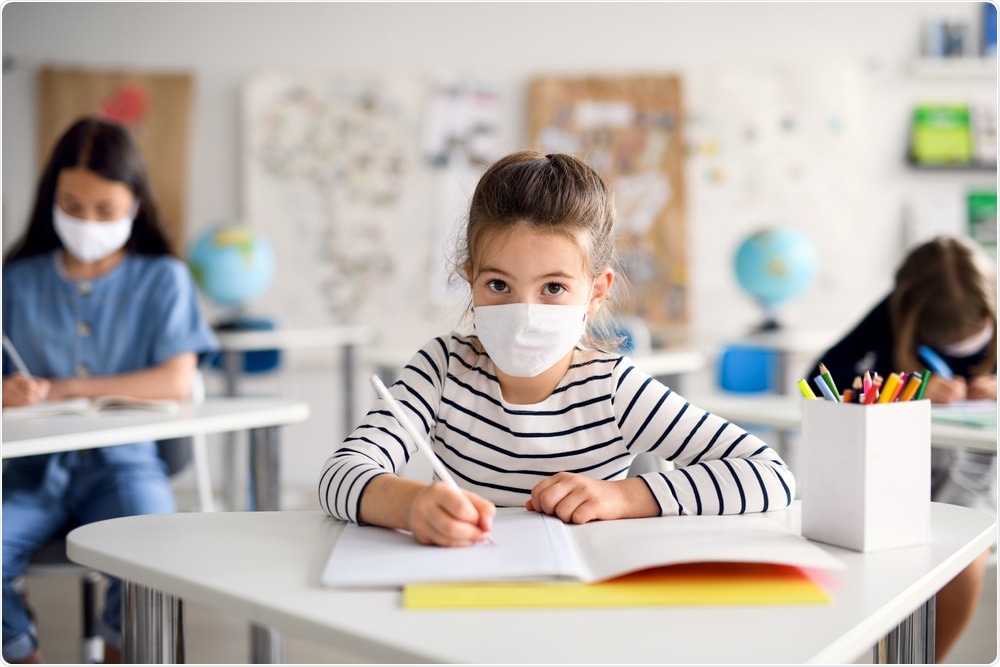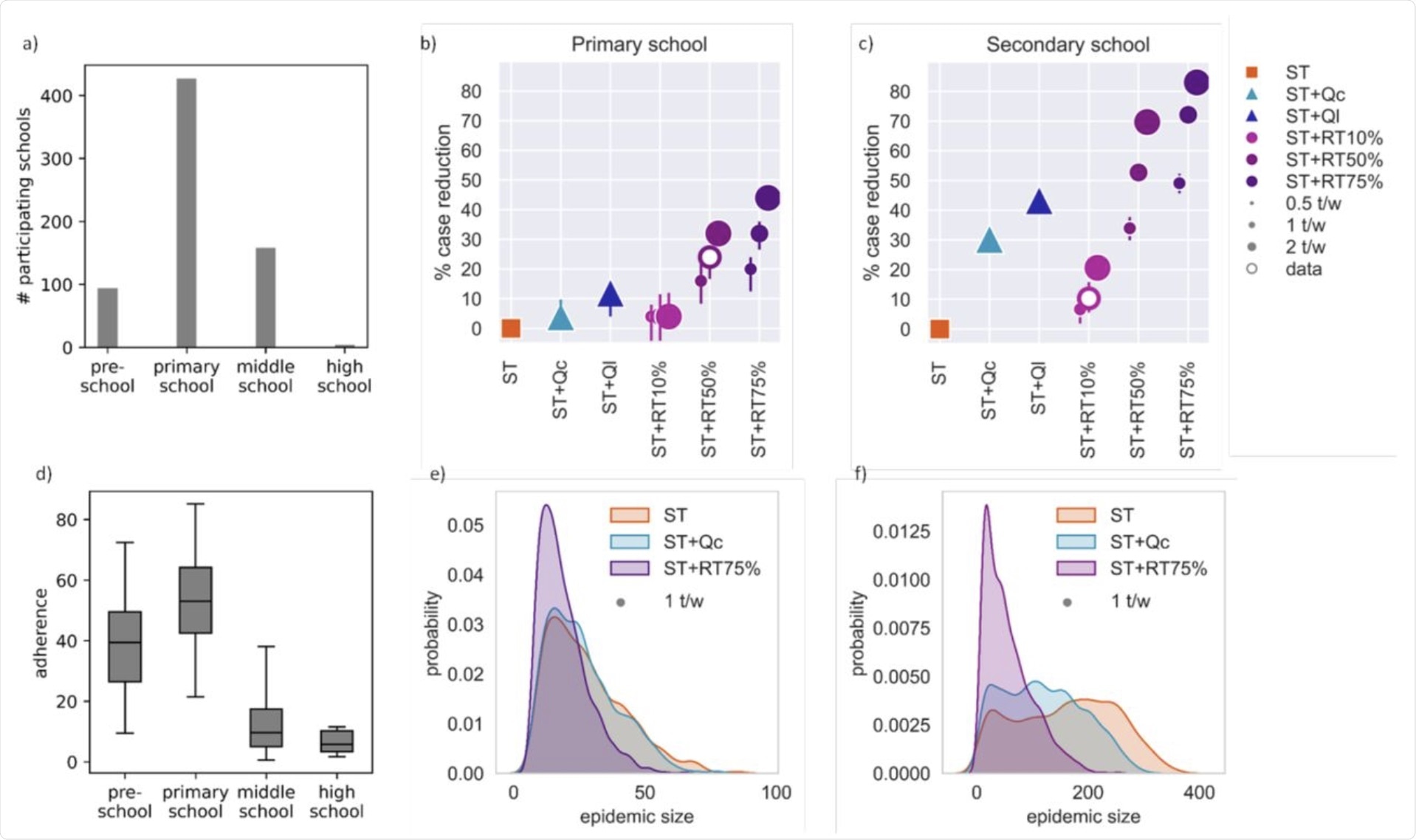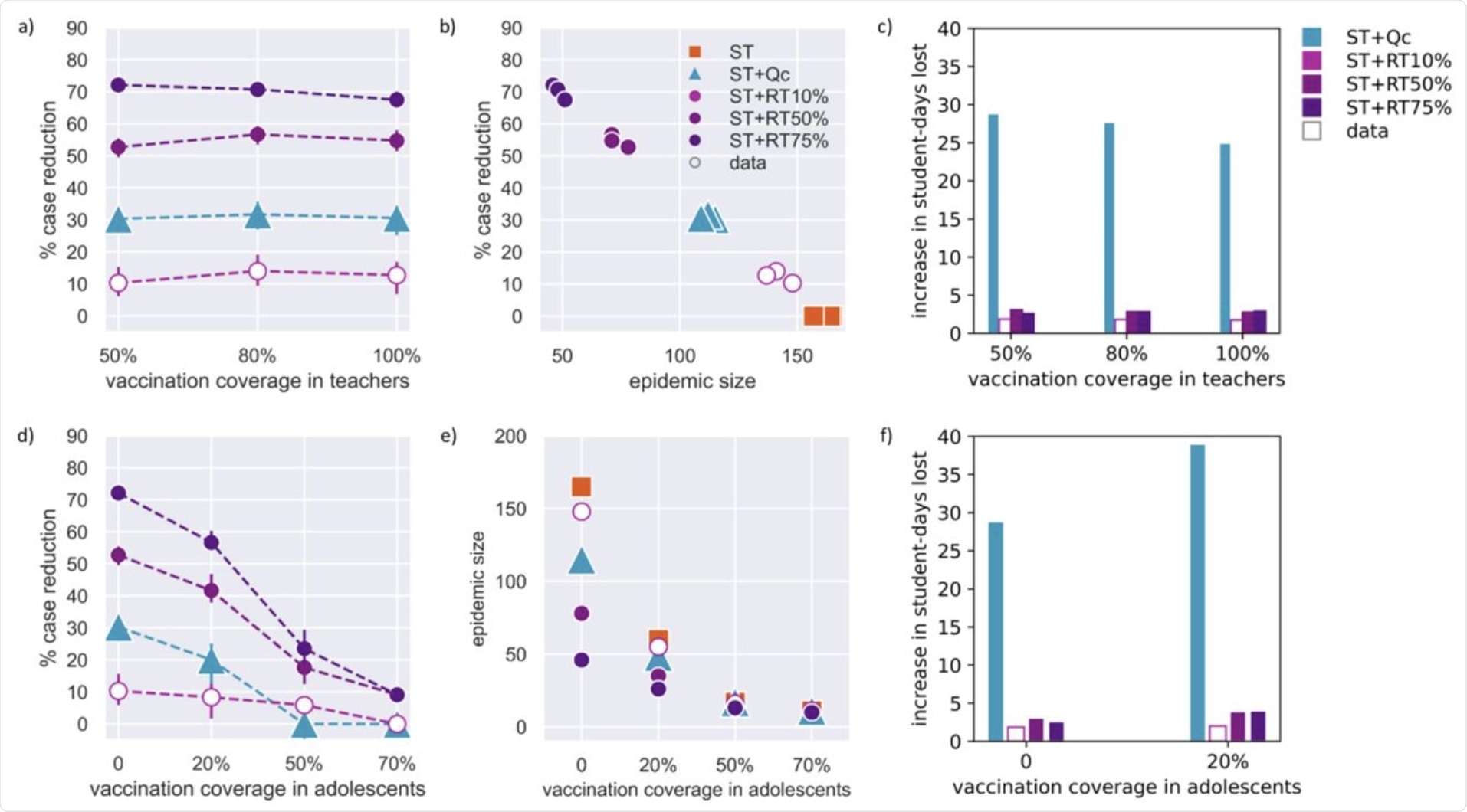As a result of the ongoing coronavirus disease 2019 (COVID-19) pandemic, schools throughout the world have closed for extended periods of time. The reopening of schools is being challenged continuously due to the emergence of new variants of the severe acute respiratory syndrome coronavirus 2 (SARS-CoV-2).
 Study: Self-testing and vaccination against COVID-19 to minimize school closure. Image Credit: Halfpoint / Shutterstock.com
Study: Self-testing and vaccination against COVID-19 to minimize school closure. Image Credit: Halfpoint / Shutterstock.com
SARS-CoV-2 in school
Outbreaks in schools are difficult to document, as most children infected with SARS-CoV-2 are either asymptomatic or have mild non-specific symptoms. Additionally, despite the lower susceptibility of children to SARS-CoV-2 as compared to adults, viral circulation can occur in the school environment.
Taken together, the opening of schools requires the implementation of safety protocols such as the use of masks, social distancing measures, hand hygiene protocols, and regular testing for COVID-19. Although vaccination has been extended to children who are 12 years of age and older in several countries around the world, it is unlikely that the majority of students will be vaccinated by the time school begins this fall. An additional threat to the safety of classrooms in the fall is the highly contagious Delta variant, which has infected an increasing number of younger individuals.
A new study published on the pre-print server medRxiv* discusses an agent-based transmission model that considers empirical contact data, as well as field data to determine age-specific differences in susceptibility of infection, contact patterns, and contagiousness to COVID-19.
About the study
The current study involved a collection of empirical contact data on both primary and secondary schools prior to the pandemic, as well as field data on adherence to screening in schools in France between March 8 and June 7, 2021. All data were collected by having students wear radio-frequency identification (RFID) sensors.
Whereas the primary school dataset consisted of 232 students and 10 teachers in October 2009, the secondary school data set consisted of 325 students from 9 different classes in December 2013. Comparatively, field data was acquired from a total of 209,564 students and 18,019 personnel from 94 pre-schools, 427 primary schools, 158 middle schools, and 4 high schools.
Next, an agent-based stochastic model was developed that involved age-specific parameters to determine transmissibility, susceptibility, probability of developing symptoms, and the probability of detecting a case based on the symptoms. In their model, children were considered to have a relative susceptibility to SARS-CoV-2 of 50%, whereas adolescents had a relative susceptibility of 75% as compared to adults.
Subsequently, symptom-based testing and case isolation (ST) were implemented in all protocols. The protocols involved included reactive quarantine of the class (ST+Qc), reactive quarantine of the class level or specialization (ST+Ql), regular testing with α adherence (ST+RTα%), regular testing with α adherence, and reactive quarantine of the class (ST+RTα%+Qc).
Study findings
In the first portion of their study, the researchers assessed how students and teachers interact with each other in both primary and secondary schools. While both types of schools appear to have a strong sense of community in the classrooms, their patterns of interactions vary greatly.
As compared to adolescents, children have a larger average number of distinct contacts throughout the day and interact with almost their entire class. In fact, approximately 50% more contacts occur between classes as compared to within classes in primary school, whereas adolescents experience 75% fewer links. However, students in both settings were found to interact more within the class than with individuals from outside the class.
The results also showed that regular testing can be an efficient preventive measure when 50% of teachers are vaccinated.
Notably, testing in schools during the third wave resulted in heterogeneous participation. In their work, the researchers found testing adherence to be highest in lower-level schools as compared to secondary schools. Furthermore, only about 50% of non-vaccinated individuals were willing to participate in these screening programs.
 (a) Number of schools participating in the screening initiative during the third wave in France, according to school level (pre-school, primary school, middle school, and high school). (b) Predicted percentage of reduction in the number of cases achieved by each intervention protocol with respect to the basic strategy of the symptom-based testing (ST) in the primary school. Intervention protocols are: symptom-based testing and case isolation, with reactive quarantine of the class (ST+Qc); symptom-based testing and case isolation, with reactive quarantine of the class level (ST+Ql); symptom-based testing and case isolation, coupled with regular testing with a percentage of adherence (ST+RTα%), with α=10%, 50%, and 75%. For regular testing, different frequencies are shown: one test every two weeks, a weekly test, two tests per week. Error bars correspond to 95% confidence intervals. The empty marker corresponds to the adherence estimated from empirical data recorded in schools of that level (from panel d). (c) As in panel b, for the secondary school. (d) Estimated adherence to screening recorded in the different school levels participating to the screening initiative in the third wave in France. Error bars correspond to 95% confidence intervals. (e) Probability distribution of the simulated final epidemic size in the primary school for selected protocols at the end of the trimester. Regular testing is done with weekly frequency. (f) As in panel e, for the secondary school.
(a) Number of schools participating in the screening initiative during the third wave in France, according to school level (pre-school, primary school, middle school, and high school). (b) Predicted percentage of reduction in the number of cases achieved by each intervention protocol with respect to the basic strategy of the symptom-based testing (ST) in the primary school. Intervention protocols are: symptom-based testing and case isolation, with reactive quarantine of the class (ST+Qc); symptom-based testing and case isolation, with reactive quarantine of the class level (ST+Ql); symptom-based testing and case isolation, coupled with regular testing with a percentage of adherence (ST+RTα%), with α=10%, 50%, and 75%. For regular testing, different frequencies are shown: one test every two weeks, a weekly test, two tests per week. Error bars correspond to 95% confidence intervals. The empty marker corresponds to the adherence estimated from empirical data recorded in schools of that level (from panel d). (c) As in panel b, for the secondary school. (d) Estimated adherence to screening recorded in the different school levels participating to the screening initiative in the third wave in France. Error bars correspond to 95% confidence intervals. (e) Probability distribution of the simulated final epidemic size in the primary school for selected protocols at the end of the trimester. Regular testing is done with weekly frequency. (f) As in panel e, for the secondary school.
“The case reduction would rise to about 30% and 70% in the two schools, respectively, by either increasing adherence to 75%, or by keeping the same participation (50%) but increasing the frequency of tests (twice a week).”
Regular testing also helps in reducing the number of days that students are absent from school by 30 to 50 times more as compared to symptom-based testing. An increase in vaccination among adolescents also acts as a strong protective factor against outbreaks in school.
“Moreover, preliminary data indicates an imperfect effectiveness of the vaccine in preventing infection and transmission due to the Delta variant [28], reinforcing the relevance of regular screening.”
 (a) Predicted percentage of reduction in the number of cases achieved by selected protocols as a function of the vaccination coverage in teachers in the secondary school. The case reduction is computed relative to the basic strategy (symptom-based testing, ST). (b) Predicted percentage of reduction in the number of cases achieved by intervention protocols as a function of the median epidemic size in the secondary school. The case reduction is computed relative to the basic strategy (symptom-based testing, ST). Dots of the same protocol for different vaccination coverage are clustered together. (c) Predicted increase in student-days lost for selected protocols as a function of the vaccination coverage in teachers in the secondary school. The increase in days lost is computed relative to the basic strategy (symptom-based testing, ST). (d) Predicted percentage of reduction in the number of cases achieved by selected protocols as a function of the vaccination coverage in adolescents in the secondary school. The case reduction is computed relative to the basic strategy (symptom-based testing, ST). (e) Predicted total epidemic size at the end of the trimester vs. the vaccination coverage in adolescents in the secondary school in selected protocols. (f) Predicted increase in student-days lost for selected protocols as a function of the vaccination coverage in adolescents in the secondary school. The increase in days lost is computed relative to the basic strategy (symptom-based testing, ST). The 50% and 70% data points are not shown as the median student-days lost for ST is equal to zero (the likelihood of generating a clinical infection among the pupils – recognizable on the basis of the symptoms – becomes low with increasing vaccination coverage). In all panels, the empty markers and bars correspond to the adherence estimated from empirical data recorded in schools of that level.
(a) Predicted percentage of reduction in the number of cases achieved by selected protocols as a function of the vaccination coverage in teachers in the secondary school. The case reduction is computed relative to the basic strategy (symptom-based testing, ST). (b) Predicted percentage of reduction in the number of cases achieved by intervention protocols as a function of the median epidemic size in the secondary school. The case reduction is computed relative to the basic strategy (symptom-based testing, ST). Dots of the same protocol for different vaccination coverage are clustered together. (c) Predicted increase in student-days lost for selected protocols as a function of the vaccination coverage in teachers in the secondary school. The increase in days lost is computed relative to the basic strategy (symptom-based testing, ST). (d) Predicted percentage of reduction in the number of cases achieved by selected protocols as a function of the vaccination coverage in adolescents in the secondary school. The case reduction is computed relative to the basic strategy (symptom-based testing, ST). (e) Predicted total epidemic size at the end of the trimester vs. the vaccination coverage in adolescents in the secondary school in selected protocols. (f) Predicted increase in student-days lost for selected protocols as a function of the vaccination coverage in adolescents in the secondary school. The increase in days lost is computed relative to the basic strategy (symptom-based testing, ST). The 50% and 70% data points are not shown as the median student-days lost for ST is equal to zero (the likelihood of generating a clinical infection among the pupils – recognizable on the basis of the symptoms – becomes low with increasing vaccination coverage). In all panels, the empty markers and bars correspond to the adherence estimated from empirical data recorded in schools of that level.
Study limitations
Although the current study is quite effective in establishing the importance of regular testing in various school environments, it has certain limitations.
First, this study focuses on contact data of two school settings, but contacts in other schools might be different. Second contacts only inside the school premises during the school hours were considered, whereas socializing activities outside the school premises were not considered. Third, the study only focuses on the school outbreaks and does not consider the impact the strategies would have on the community.
*Important notice
medRxiv publishes preliminary scientific reports that are not peer-reviewed and, therefore, should not be regarded as conclusive, guide clinical practice/health-related behavior, or treated as established information.
- Colosi, E., Bassignana, G., Contreras, D. A., et al. (2021). Self-testing and vaccination against COVID-19 to minimize school closure. medRxiv. doi:10.1101/2021.08.15.21261243. https://www.medrxiv.org/content/10.1101/2021.08.15.21261243v1
Posted in: Child Health News | Medical Research News | Disease/Infection News
Tags: Adolescents, Child Health, Children, Children's Health, Coronavirus, Coronavirus Disease COVID-19, Frequency, Hygiene, Pandemic, QC, Respiratory, SARS, SARS-CoV-2, Severe Acute Respiratory, Severe Acute Respiratory Syndrome, students, Syndrome, Vaccine

Written by
Suchandrima Bhowmik
Suchandrima has a Bachelor of Science (B.Sc.) degree in Microbiology and a Master of Science (M.Sc.) degree in Microbiology from the University of Calcutta, India. The study of health and diseases was always very important to her. In addition to Microbiology, she also gained extensive knowledge in Biochemistry, Immunology, Medical Microbiology, Metabolism, and Biotechnology as part of her master's degree.
Source: Read Full Article






